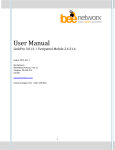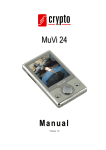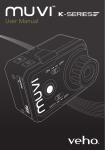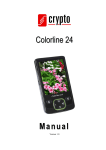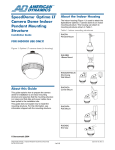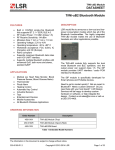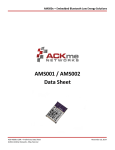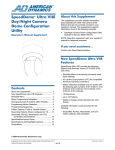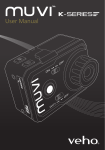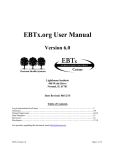Download Wearable Camera Systems -- Assessment Summary
Transcript
March 2012 System Assessment and Validation for Emergency Responders (SAVER) Summary Wearable Camera Systems (AEL reference number 13LE-00-SURV) The U.S. Department of Homeland Security (DHS) established the System Assessment and Validation for Emergency Responders (SAVER) Program to assist emergency responders making procurement decisions. In order to provide emergency responders with information on currently available wearable camera systems, the Space and Naval Warfare Systems Center (SPAWARSYSCEN) Atlantic conducted a comparative assessment of wearable camera systems for the System Assessment and Validation for Emergency Responders (SAVER) Program in June 2011. Detailed findings are provided in the Wearable Camera Systems Assessment Report, which is available by request at https://www.rkb.us/saver. Located within the Science and Technology Directorate (S&T) of DHS, the SAVER Program conducts objective assessments and validations on commercial equipment and systems, and provides those results along with other relevant equipment information to the emergency response community in an operationally useful form. SAVER provides information on equipment that falls within the categories listed in the DHS Authorized Equipment List (AEL). Background The SAVER Program is supported by a network of technical agents who perform assessment and validation activities. Further, SAVER focuses primarily on two main questions for the emergency responder community: “What equipment is available?” and “How does it perform?” Prior to the assessment, seven emergency responders were chosen from various jurisdictions to participate in a focus group. Participants possessed strong backgrounds in law enforcement, specifically patrol operations, narcotics, information technology analysis, and airport security. The group’s primary objectives were to recommend evaluation criteria, product selection criteria, products and vendors, and possible scenarios for the assessment. For more information on this and other technologies, contact the SAVER Program Support Office. Based on focus group recommendations, market research, and system availability, the following wearable camera systems were assessed: RKB/SAVER Telephone: 877-336-2752 E-mail: [email protected] Web site: https://www.rkb.us/saver Wearable camera systems are valuable tools used by patrol officers to record traffic stops, sobriety tests, and interviews. A wearable camera system typically includes a camera, microphone, battery pack, and video storage. Depending on the model, wearable camera systems are designed to be head-mounted or worn on the body. Assessment Methodology ● ● ● ● ● Reference herein to any specific commercial products, processes, or services by trade name, trademark, manufacturer, or otherwise does not constitute or imply its endorsement, recommendation, or favoring by the U.S. Government. Neither the U.S. Government nor any of its employees make any warranty, expressed or implied, including but not limited to the warranties of merchantability and fitness for a particular purpose for any specific commercial product, process, or service referenced herein. POV.T, V.I.O. Inc.; PVR-LE2, VIEVU LLC; Muvi-LE Pro, MPH Industries; AXON®, TASER International Inc.; and First Vu™, Digital Ally. Four responders, each with a strong law enforcement background, served as evaluators for this assessment. These responders were members of detective, livability, metro narcotics, and patrol/special weapons and tactics units. Evaluators were tasked to participate in two phases of the assessment: the specification assessment and the operational assessment. During the specification assessment, evaluators assessed the systems based on vendor-provided product information and specifications. Hands-on experience with the systems during three scenarios—a field sobriety test, a vehicle search, and a residential call—served as the basis for the operational assessment. Assessment Results SAVER Category Definitions Evaluators rated the wearable camera systems based on the evaluation criteria established by the focus group. The focus group assigned each criterion to one of the five SAVER categories, and then assigned a weight for its level of importance. Once the criteria were weighted, the five SAVER categories were assigned a percentage value to represent the level of each category’s importance relative to the other categories. Table 1 displays the composite assessment scores as well as the category scores for each product. Higher scores indicate a higher rating by evaluators. The advantages and disadvantages of each system, as identified by evaluators, are listed in table 2. To view how each wearable camera system scored against the evaluation criteria assigned to the SAVER categories, see table 3. For product specifications, see table 4. Affordability groups criteria related to life-cycle costs of a piece of equipment or system. Capability groups criteria related to the power, capacity, or features available for a piece of equipment or system to perform or assist the responder in performing one or more relevant tasks. Deployability groups criteria related to the movement, installation, or implementation of a piece of equipment or system by responders at the site of its intended use. Maintainability groups criteria related to the maintenance and restoration of a piece of equipment or system to operational condition by responders. Usability groups criteria related to the quality of the responders’ experience with the operational employment of a piece of equipment or system. This includes the relative ease of use, efficiency, and overall satisfaction of the responders with the equipment or system. The following paragraphs provide a brief summary of evaluator comments and feedback on each wearable camera system used during the assessment; the complete assessment report includes a breakdown of evaluator comments by SAVER category. The systems are listed from highest to lowest composite score. POV.T The POV.T received a composite score of 3.4. The POV.T costs $676 and includes the following: a mountable camera head with a tethered video recorder, a 4-gigabyte micro secure digital (SD) card, a universal serial bus (USB) cable, a wireless remote, video management software, a user manual, a 1-year warranty, and technical support. POV.T Details in the recorded video were clear and sharp in normal lighting conditions, especially during the traffic stop scenarios. The image quality of the video captured during the residential call scenario was good when a flashlight was used. The field of view captured on the video was wide, and the camera was able to capture—from head to toe—an individual standing 8 to 10 feet away. Video can be transferred quickly and easily using either the included USB cable or a removable microSD card. The video is date/time stamped, and important points in the video can be tagged while recording, making them easy to locate when viewing or editing the video; however, video tagging Table 1. Wearable Camera System Assessment Results Composite Score Affordability Capability Deployability Maintainability Usability (7% Weighting) (35% Weighting) (20% Weighting) (13% Weighting) (25% Weighting) POV.T 3.4 3.8 3.3 3.1 3.8 3.6 PVR-LE2 3.4 3.0 3.2 3.8 3.3 3.5 Muvi-LE Pro 3.3 3.8 2.8 3.6 3.5 3.5 AXON® 3.3 2.3 3.7 2.6 3.3 3.6 First Vu™ 3.0 2.8 3.1 2.9 3.8 2.8 System 2 cannot log global positioning system (GPS) coordinates. Battery life and storage capacity indicators are favorably located on the camera. Settings in the software can be adjusted to turn the microphone off, which may be beneficial for agencies that are not authorized to record audio. Video can be edited after it has been downloaded from the system. It is easy to play back video and to adjust the volume on the system. The camera is easily turned on and off with or without gloves. The system appears to be durable and built extremely well. The system has an excellent operating temperature range but would likely need to be stored in a controlled environment when temperatures are at extremes. The camera has favorable attachment options; it remained in place when evaluators were running, and it did not become entangled in the evaluators’ seatbelts. The battery compartment is easily accessed in the field; no tools are required. The cost of the system is competitive, and ongoing costs are minimal. The system does not feature a low-lux camera, and it is not equipped with an illuminator. During the residential call scenario in low-light conditions, the video captured what was illuminated by the flashlight, but surroundings that were visible to the naked eye were not visible in the video. Objects and people cannot be observed without direct artificial lighting in low-light conditions. Checking on system status is inconvenient, as the system indicators are located on the recorder, which must be stored in a pocket or holster. The audio is not clear; the microphone is part of the cable that connects the recorder and the camera, and it picks up noise from rubbing on clothing and equipment. Using a microSD card for data storage could compromise data security; once removed, it could be lost, stolen, or destroyed. The system is excessive in size and weight, and the video recorder component does not come with any type of attachment method. PVR-LE2 The PVR-LE2 received a composite score of 3.4. The PVR-LE2 costs $900 and includes the following: a proprietary USB cable, a 110-volt wall charger, a 12-volt car charger, VERIPATROL software and future updates, a 90-day warranty, a user manual, technical support, and training. Security of the video is excellent, as users are unable to edit the video. The system indicators are located on top of the device and are easily PVR-LE2 understood. The image is clear in low-light conditions if a flashlight is used. The audio quality is great even though it is not in stereo. Video is date/time stamped, and users can add a case number or comments using the included VERIPATROL software; however, video tagging does not log GPS coordinates. Data transfer is easy, but requires the included proprietary cable. The 4-gigabyte data storage capacity should be sufficient for most operations since data can be transferred while the unit is charging and the unit can be charged in a patrol car; however, expandable data storage is preferred. The system can be charged quickly and easily with a USB cable that plugs into a wall charger or computer USB port. It is easy to start recording video with or without gloves, and unintentional recording is not likely to occur. The unit is small, lightweight, compact, and easy to use. The software is user friendly, and future updates are included with system purchase. The unit can be clipped on a shirt just below pocket level; it is easy to attach and remains in place when the user is running. The unit did not interfere with user maneuverability. The system has a favorable operating temperature range. The image quality is clear with minimal distortion, but the camera captures a limited field of view; during the field sobriety test scenario, the camera did not capture an image of the suspect from the waist down. The microphone is always on when capturing video; this may be an issue in jurisdictions that do not permit audio recording. The system is not equipped with an illuminator. The system does not feature instant video playback directly on the device; however, video could be easily viewed on a mobile data terminal. Depending on where the unit is attached to the chest, it is possible that it might interfere with the user’s seatbelt. The storage temperature range is limited; the system will need to be stored in a controlled environment when temperatures are at extremes. The unit is sealed with a permanently installed battery so the entire unit must be replaced when the battery will no longer hold a charge, making the value of the system a little less favorable. 3 Muvi-LE Pro The Muvi-LE-Pro received a composite score of 3.3. The Muvi-LE Pro costs $119 and includes the following: a Muvi micro DV camcorder, a 4-gigabyte microSD card, a USB cable, a software disc, a spring mounting clip, a nylon lanyard, a carrying pouch, a user manual, a 1-year warranty, and technical support. The system indicators are easy to see and understand. Data can be quickly and easily transferred via the included USB cable or removable microSD card. The unit is easy to use and extremely compact and Muvi-LE Pro lightweight. The camera is easy to turn on and off with or without gloves. The unit is easy to wear; it clips on a shirt pocket, stays in place when the user is running, and does not interfere with maneuverability. The unit appears to be durable; however, audio recording is negatively affected when the waterproof sleeve is used. The unit has good operating and storage temperature ranges but it would likely need to be stored in a controlled environment when temperatures are at extremes. The system can be charged with the included USB cable. The initial cost is relatively low, and there are no recurring costs for continued operation of the system; the camera must be replaced when the battery will no longer hold a charge, but considering the low cost of the unit, this is acceptable. The image quality was less than favorable; video paused during playback and the audio was not always in sync with the video. The system has a 2-hour battery run time and would require frequent charging during an 8-hour shift, though it is easy to recharge the unit. The field of view is narrow, and the video appeared shaky at times. The video is date/time stamped, but users cannot add additional tags, notes, or case numbers. The microphone is always on when capturing video, which may be an issue in jurisdictions that do not permit audio recording. Objects and people are difficult to identify in video captured in low-light conditions; additional lighting (e.g., a flashlight) is required to obtain a clear image under these conditions. The system is not equipped with an illuminator. Using a microSD card for data storage could compromise data security; once removed, it could be lost, stolen, or destroyed. The narrow field of view makes it difficult to ensure the camera is capturing what the user is seeing. The evaluators had to turn their bodies in the direction of the subjects to capture them on video; the subjects were not captured on the video if the evaluators were in a bladed stance. It is not possible to instantly view video on the unit. It is possible that the unit could interfere with the user’s seatbelt depending on the size of the user and the placement of the device. The unit is sealed with a permanently installed battery. AXON The AXON received a composite score of 3.3. The AXON costs $3,030 and includes the following: an AXON tactical computer, communications hub, and head-mounted camera; a headband mount; SYNAPSE™ evidence transfer manager docking station; 1 year of EVIDENCE.COM™ usage; a 1-year warranty; and a user manual. The wide-angle field of view captures a large area. The video has excellent image quality and clarity. The system records well in low-light AXON conditions; people and objects were identifiable when a flashlight was used. The system has an excellent battery life. The system’s 16-gigabyte internal storage is adequate and likely sufficient for an 8-hour shift; however, no add-on storage is available. In addition to visual indicators, the system has audio prompts that inform the user when it is recording and when video has been tagged. The audio quality recorded with the video is good. Video is date/time stamped and metadata includes GPS coordinates; users can add descriptions to the tags when reviewing the video. The microphone is built into the system and cannot be detached; however, software settings can be adjusted to turn off the microphone, which is good for agencies that are not authorized to record audio. Instant video playback on the AXON tactical computer is quick and easy. The system has a head-mounted camera that captures the user’s point-of-view. Video recording is easy to start and stop with or without gloves. The system appears to be rugged and well 4 built. The system has a favorable operating temperature range, but it would likely need to be stored in a controlled environment when temperatures are at extremes. The battery can be ordered from TASER and replaced by the user, but tools are required. The system indicators convey excellent information; however, the indicators are located on the AXON tactical computer’s display, which evaluators typically placed in their pockets during the assessment. The system is not equipped with an illuminator. The system provides good data security; however, video is stored on the third party server, EVIDENCE.COM. The system must be docked with a connection to the Internet in order to transfer video to EVIDENCE.COM. If the connection to the Internet is lost, the unit will lock until the connection is restored; if an Internet connection is not available, users cannot download or upload video. Users must press the start/stop button twice, which is not user friendly. The AXON tactical computer is large and heavy and would be difficult to add to a gun belt. There was some concern that the system would be dropped a lot due to the number of components and cables. The AXON tactical computer does not have a clip for a gun belt and finding an appropriate attachment point is difficult. While the system did not seem to interfere with getting in or out of a vehicle, it does affect user maneuverability; the cable that runs from the AXON tactical computer to the communications hub and then to the head-mounted camera is not long enough and it interferes with a user’s ability to freely move his or her head. The unit can only be charged in the docking station. The higher than average initial cost and the recurring costs (i.e., EVIDENCE.COM subscription) may be too expensive for some agencies. First Vu The First Vu received a composite score of 3.0. The First Vu costs $995 and includes the following: a camera unit, earphones, a USB cable, a 120-volt alternating current (AC) battery charger, a 12-volt direct current (DC) battery charger, a quick start guide, an operation manual, a VideoManager and Configuration software DVD, a 1-year warranty, technical support, and operational training. The data storage options on this system are excellent; users can store video to the 16-gigabyte internal storage or to the 8-gigabyte removable microSD card. Data storage can be expanded up to a 32-gigabyte microSD card. Video is date/time stamped, and users can add case numbers and notes when video is reviewed; however, video tagging cannot log GPS coordinates. The camera acts as an external hard drive, and video can be accessed without the software. Video can be transferred from the device via a USB cable (included) or a microSD card (not included). The system did not feature an illuminator; however, an illuminator is available as an option. The point of view is good, and the wide field of view helps capture most things in the user’s line of sight. The system is compact and lightweight for a system with a monitor. Instant video playback on the device is easy; however, there is no speaker for audio playback and headphones must be used. The system has an excellent operating temperature range. The system had minimal interference with users’ maneuverability. The unit can be charged with a DC charger, an AC charger, or the included USB cable. The battery is user replaceable, and no tools are required to access the battery compartment. While the initial cost of the system is higher than some of the other systems assessed, there are no recurring costs. First Vu The audio quality is good; however, the microphone picked up some external noise (i.e., wind, etc.). The 4-hour battery run time and high number of charge cycles are favorable; however, the battery would require charging if used continuously throughout an 8- to 12-hour shift. The image quality is good, but the video appeared choppy at times and the audio did not sync up with the video. Some evaluators experienced slow data transfer. Using a microSD card for data storage could compromise data security; once removed, it could be lost, stolen, or destroyed. Video appeared dark in low-light conditions and no details of objects outside of the flashlight beam were evident when reviewing the video. The system indicators are favorable; however, the location of the indicators on the front of the device is less favorable as the controls are located on the back. Video recording is easily activated, but the smaller size of the buttons may make it difficult for some users to press them, especially when wearing gloves. The camera takes some time to boot up and begin recording. 5 The durability of the camera is less favorable due to its plastic housing. The unit attaches to a shirt or tactical vest with a clip; some evaluators found the camera to be heavy for attachment to their shirt, and the mounting clip broke during the assessment. The unit bounced when users were running, capturing the sky on video. It would be more favorable if alternate attachment options were included in the initial cost. Conclusion All five wearable camera systems scored favorably overall, and evaluators indicated that all five systems would be suitable for most overt operations. Emergency response agencies that may be considering the purchase of wearable camera systems for patrol operations should carefully consider each system’s overall capabilities and limitations in relation to their jurisdiction’s operational needs. All reports in this series, as well as reports on other technologies, are available in the SAVER section of the Responder Knowledge Base (RKB) Web site at https://www.rkb.us/saver. Table 2. Wearable Camera System Advantages and Disadvantages System POV.T Composite Score: 3.4 PVR-LE2 Composite Score: 3.4 Advantages Disadvantages ● Clear and sharp images in normal lighting ● Video recorder is large and does not have a conditions ● Wide-angle field of view ● Quick and easy data transfer ● Easy video playback on the device ● Cable interferes with user maneuverability ● Audio is not clear mounting bracket ● Wearable component is small, lightweight, ● ● ● ● Muvi-LE Pro Composite Score: 3.3 ● ● ● ● AXON® Composite Score: 3.3 ● ● ● ● and compact System is easy to use Video recording is simple to start/stop Video cannot be modified or erased by users Great audio quality Compact and lightweight unit Easy to start/stop video recording Multiple charging methods Data transfer via USB cable or removable microSD card ● Video is date/time stamped Records well in low-light conditions Video is tagged with GPS coordinates Wide-angle field of view Head-mounted camera captures the user’s point of view ● Narrow field of view ● The rechargeable battery cannot be replaced because it is permanently installed ● Users must be careful when the device is attached to ensure an accurate point of view ● No instant video playback ● ● ● ● ● ● Video pauses unintentionally during playback Audio and video are not always in sync Narrow field-of-view Two-hour battery run time No video tagging No instant video playback ● Internet connection and docking station are required to transfer data from the device ● Video is uploaded and stored to a third-party server ● The AXON tactical computer is too large and bulky ● The cable connecting the AXON tactical computer to the camera is too short and interferes with user maneuverability First Vu™ Composite Score: 3.0 ● Multiple and expandable data ● Video appears distorted with a fish-eye look storage options ● Video is date/time stamped, and users can add notes and case numbers easily ● Up to 500 charge cycles before battery replacement ● Users can play back video instantly on the device to it ● Audio not always in sync with video ● Camera takes time to boot up ● System indicators and camera controls are on opposite side of the camera ● The system has limited attachment options Notes: GPS SD = = global positioning system secure digital USB 6 = universal serial bus Table 3. Wearable Camera System Criteria Ratings1 KEY Least Favorable Most Favorable POV.T PVR-LE2 Muvi-LE Pro AXON® First Vu™ Affordability Value Capability Image quality Day/night operations Power Data storage Field of view System indicators Audio quality Data security Video tagging Microphone options Data transfer Illumination control Deployability Attachment options Durability Operating/storage temperatures Interference Maintainability Recharge method/time Battery access Usability Physical characteristics Camera activation Instant video playback Point of view Software requirements Note: 1 Averaged criteria ratings for each assessed product are graphically represented by colored and shaded circles. Highest ratings are represented by full green circles. 7 Table 4. Wearable Camera System Specifications1 Specifications POV.T PVR-LE2 Muvi-LE Pro AXON® First Vu™ $676 $900 $119 $3,0302 $995 2.7 x 0.8 inches (length x diameter) 3.0 x 2.0 x 0.8 inches 2.2 x 1.1 x 0.8 inches 2.3 x 1.1 x 0.8 inches 4.3 x 2.8 x 1.0 inches 2.0 ounces 3.5 ounces 1.8 ounces 1.2 ounces 6.5 ounces Operating temperature 14° to 140°F -4° to 140°F 14° to 140°F -4° to 122°F -4° to 158°F Storage temperature 14° to 140°F 23° to 95°F Not provided by vendor MSRP Camera dimensions (L x W x H) Camera weight 23° to 95°F -10° to 175°F (up to 1 month) 32° to 95°F (up to 6 months) Minimal resistance to Drop tested from 7 feet Drop tested from 6 feet shock and vibration Yes with waterproof Yes Yes sleeve ($49.95) 3 hours 9.5 hours 16 hours 14° to 158°F Water resistant Yes Drop tested from 10 feet Yes Recording time 8.3 hours 4 hours Field of view 110 degrees 71 degrees 72 degrees 110 degrees 133 degrees Battery type 4 AA batteries (lithium recommended) Proprietary, built-in (non-replaceable) Proprietary, built-in (non-replaceable) Proprietary, rechargeable lithium ion battery Proprietary, rechargeable lithium ion battery Battery run time (with continuous use) 10 hours with lithium batteries 4 hours 3 hours 12 hours 4 hours N/A 3 hours 2 hours 4 hours 2.5 to 3 hours N/A (disposable or rechargeable AA batteries) 400 Information not provided 400 500 4GB removable microSD 4GB internal memory 4GB removable microSD 16GB internal memory 16GB internal memory; 8GB removable microSD Expandable data storage Yes; up to an 8GB microSD No Yes; up to an 8GB microSD No Yes; up to a 32GB microSD System indicators on camera LED: Recording indicator Durability Battery charge time Charge cycles (before suggested replacement of rechargeable battery) Data storage Overt or covert system indicators LEDs indicate when LED flashes different LCD: Battery indicator, LCD: Battery status, battery is fully charged colors and speeds to low-battery alert, recording time remaining or when 20 percent of indicate camera mode storage capacity, low LCD: Battery and time or free space storage alert, recording LED: Camera mode storage capacity status indicator, privacy mode remains engaged, GPS lock Overt Overt Covert Overt or covert (adjust setting) Covert Notes: 1 2 F GB GPS H Information was provided by manufacturers and has not been independently verified by the SAVER Program. Includes 12 months of EVIDENCE.COM usage, which costs $1,200 a year (required for downloading video from system). = = = = Fahrenheit gigabyte global positioning system height L LCD LED MSRP = = = = length liquid crystal display light-emitting diode manufacturer suggested retail price 8 N/A SD W = = = not applicable secure digital width








